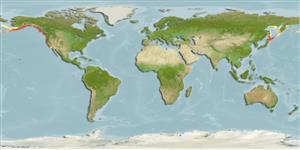Common names from other countries
Environment: milieu / climate zone / depth range / distribution range
Écologie
; profondeur 0 - 200 m (Ref. 114918). Temperate, preferred 5°C (Ref. 107945); 68°N - 32°N, 167°W - 164°E
Arctic, Northwest and Eastern Pacific: from California (San Diego), Alaska, Chukchi Sea and Aleutian Islands to Kamchatka and northern Japan (Hokkaido). Subtropical to boreal.
Length at first maturity / Taille / Poids / Âge
Maturity: Lm ? range ? - ? cm Max length : 14.0 cm SHL mâle / non sexé; (Ref. 95344); âge max. reporté: 18 années (Ref. 8702)
Found along the intertidal zone, in sheltered areas in sand-gravel substrate (Ref. 95344).
Life cycle and mating behavior
Maturité | Reproduction | Frai | Œufs | Fécondité | Larves
Members of the class Bivalvia are mostly gonochoric, some are protandric hermaphrodites. Life cycle: Embryos develop into free-swimming trocophore larvae, succeeded by the bivalve veliger, resembling a miniature clam.
GBIF. 2007. (Ref. 8310)
Statut dans la liste rouge de l'IUCN (Ref. 130435)
statut CITES (Ref. 108899)
Not Evaluated
Not Evaluated
Utilisations par l'homme
Pêcheries: commercial
FAO - pêcheries: landings | FishSource | Sea Around Us
Outils
Sources Internet
Estimates based on models
Preferred temperature
(Ref.
115969): 4.6 - 14.3, mean 8.8 (based on 266 cells).
